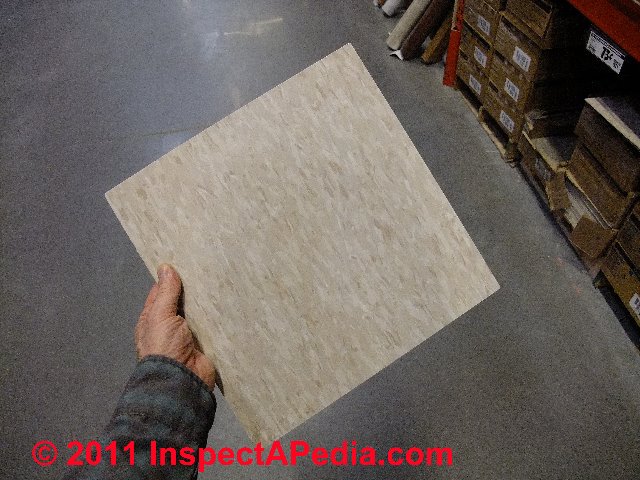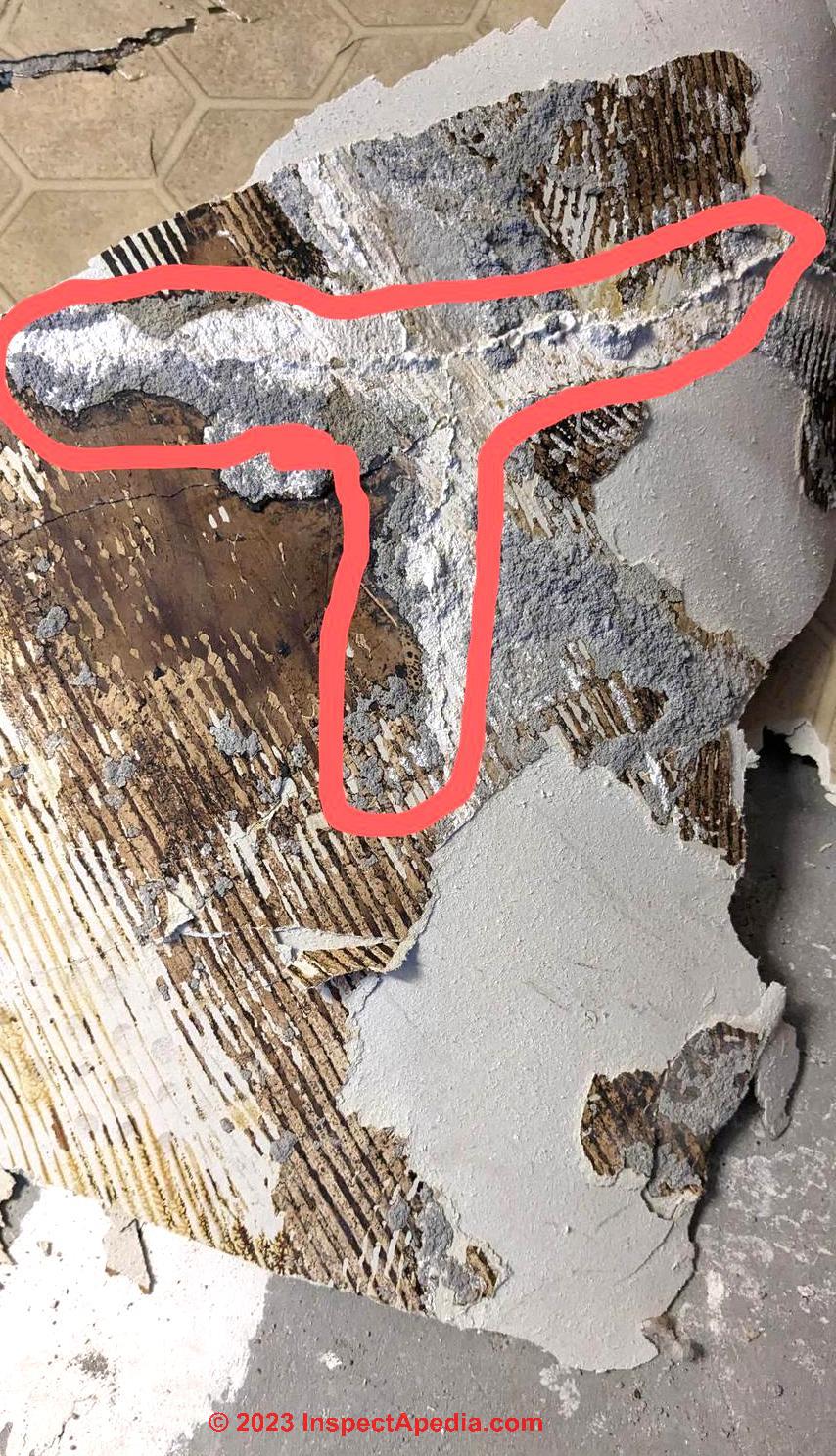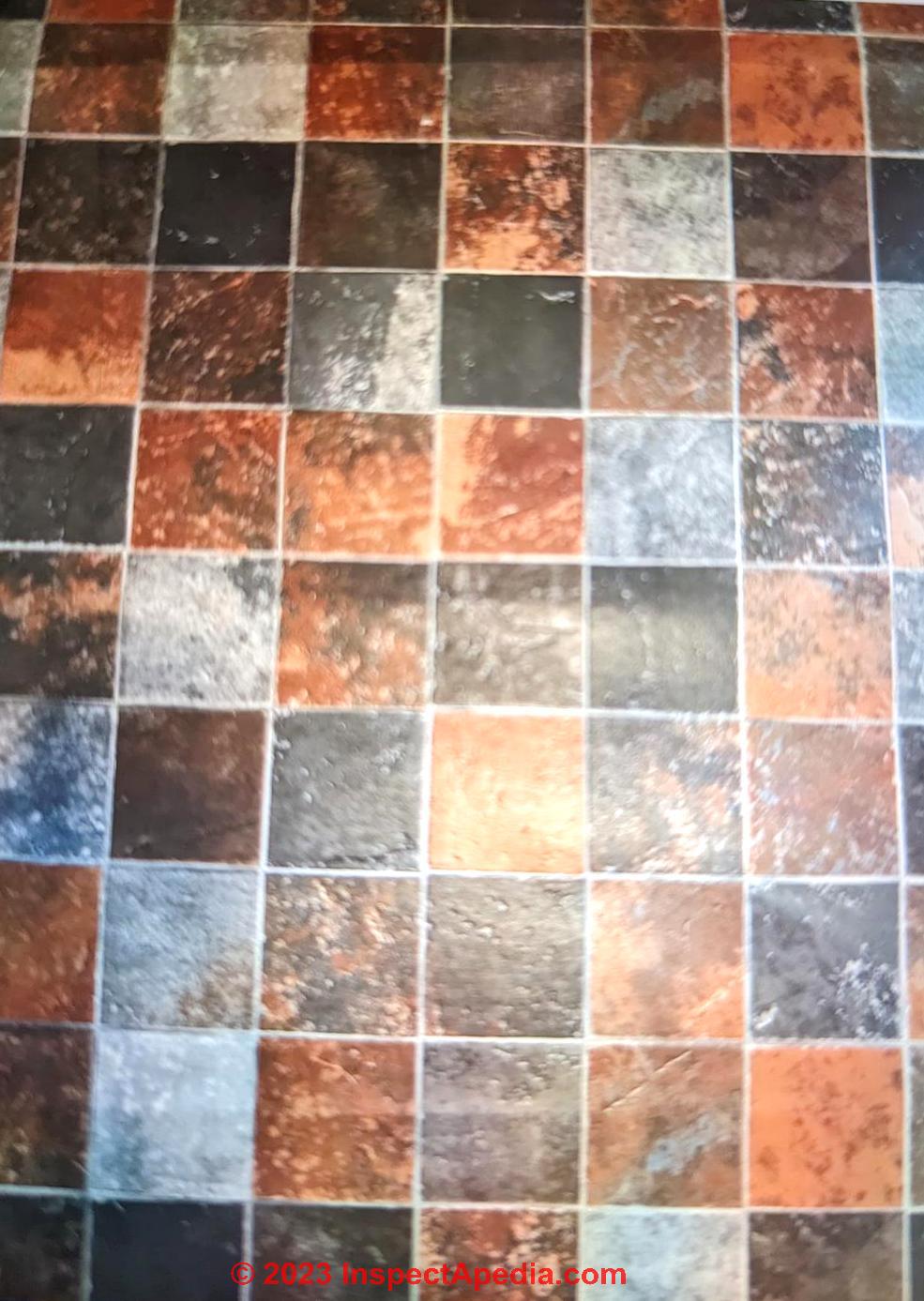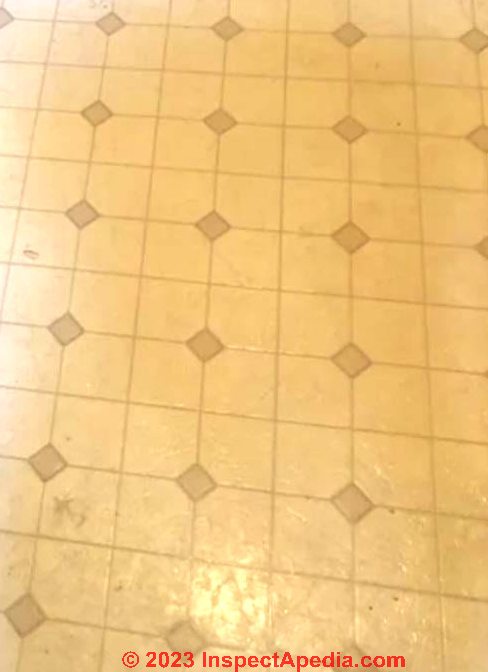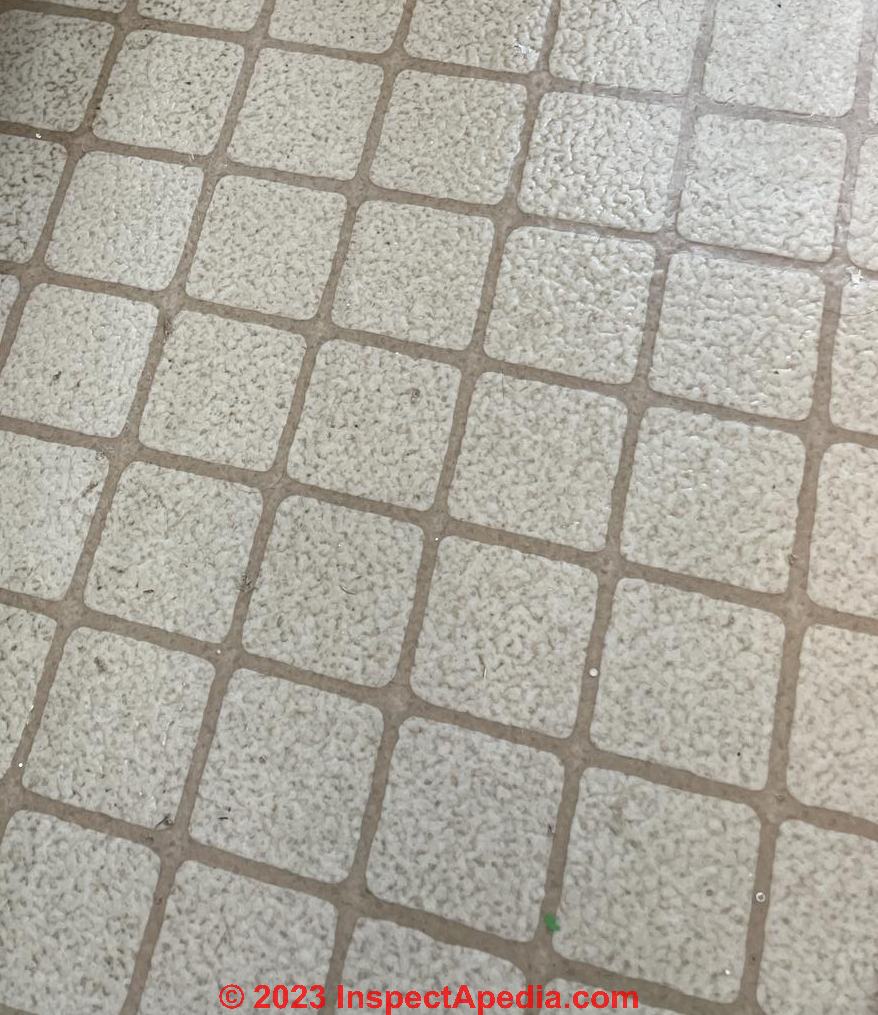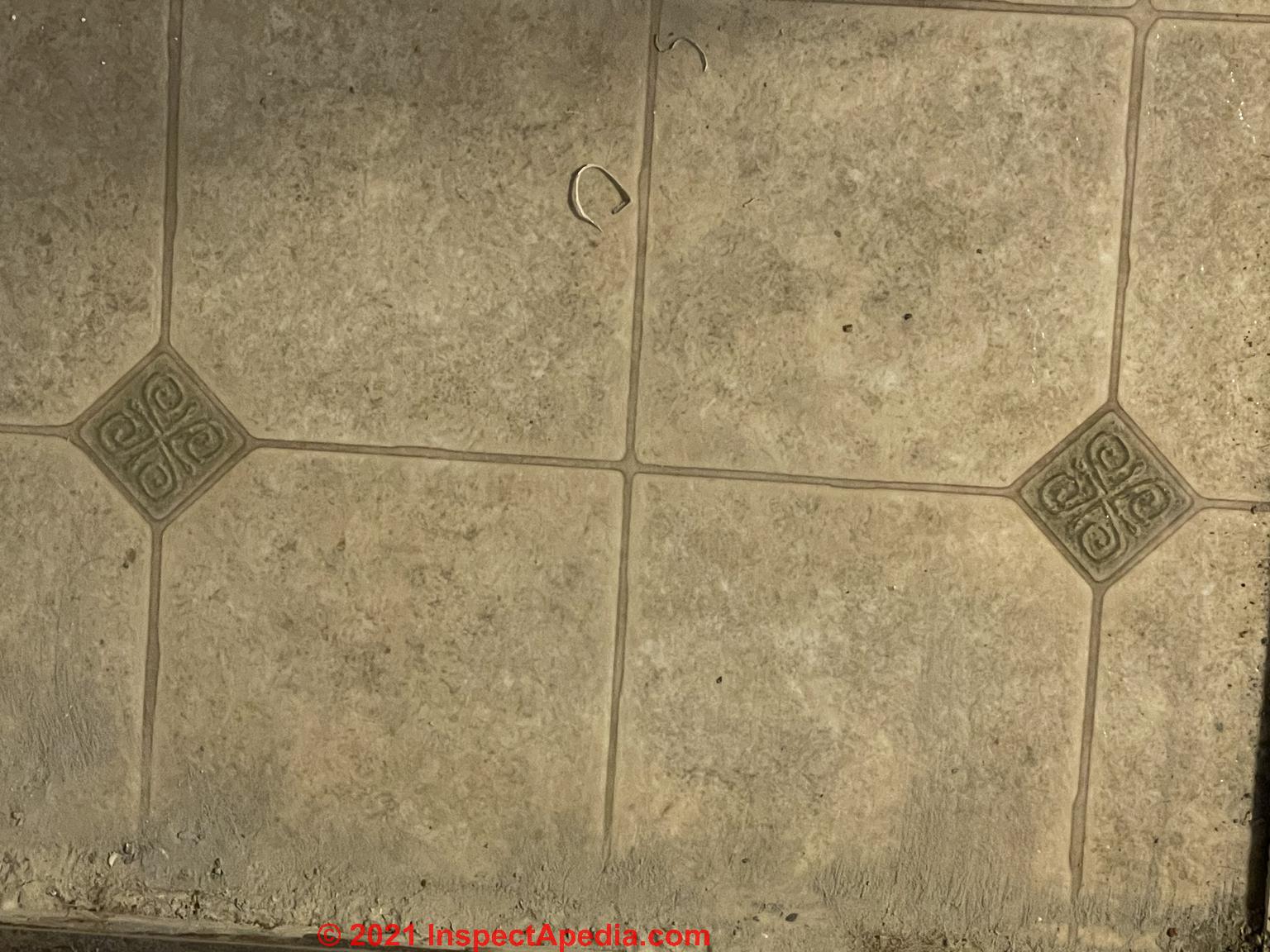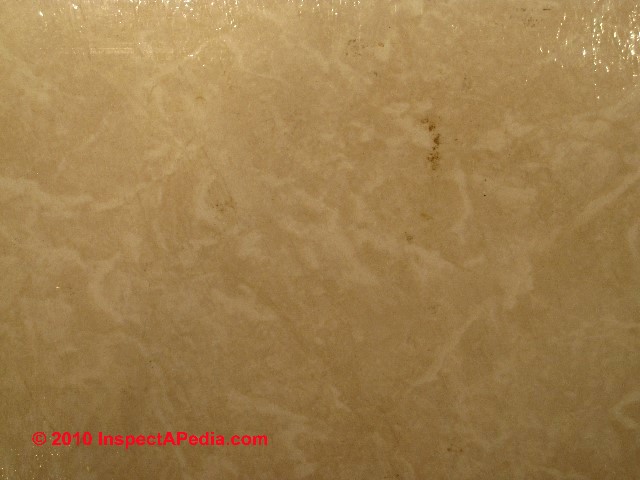 Armstrong Floor Tiles & Sheet Identification Photos 1989 & Later
Armstrong Floor Tiles & Sheet Identification Photos 1989 & Later
- POST a QUESTION or COMMENT about how to identify brands & types of vinyl & vinyl-asbestos floor tiles & sheet flooring & about the asbestos content of these products
Armstrong Flooring & Tile Identification from 1989 & later: these floor coverings would not be expected to contain asbestos.
This article describes modern Armstrong flooring products and provides identification photos for flooring produced in 1989 and later.
These flooring products would not contain asbestos.
Page top photo: close-up view of color and texture of an Armstrong self-stick floor tile from the late 1980's - not containing asbestos.
This article series provides a guide to identifying asphalt-asbestos flooring (1917 - ca 1960) & vinyl asbestos floor tile (ca 1952 - 1986) and includes photographs of floor coverings including vinyl floor tiles made after 1986 that would not be expected to contain asbestos.
InspectAPedia tolerates no conflicts of interest. We have no relationship with advertisers, products, or services discussed at this website.
- Daniel Friedman, Publisher/Editor/Author - See WHO ARE WE?
Vinyl Asbestos Floor Tiles Product History and Product Name List

Asphalt asbestos and vinyl-asbestos floor tiles were produced in 9" x 9", 12" x 12", and even 18" x 18" as well as in decorative strips, and in thicknesses of 1/16", 3/32", and 1/8", also in 0.08 gauge.
Above we show the Armstrong© Stamp found on the under-side or "back" of 12 x 12 "stick-on" self-adhesive floor tiles produced by Armstrong.
From the late 1980's this flooring is an asbestos-free flooring product.
This photo guide to asphalt asbestos & vinyl asbestos floor tiles for each year shows at least one color photo of each floor tile style or pattern in an example color.
A list below each group of photos includes the names of and links to additional photos for other colors of these styles.
Asbestos is safe and legal to remain in homes or public buildings as long as the asbestos materials are in good condition and the asbestos can not be released into the air.
Below we provide an extensive photo-dictionary of resilient flooring, floor tiles, and sheet flooring, with focus on older floor coverings that are known to contain asbestos.
For a quick check and five easy questions that can help tell you if an unknown floor covering contains asbestos, try
DOES THIS FLOORING CONTAIN ASBESTOS?
Modern Armstrong 12"x12" x 1/16" (1.5mm) Self-Adhesive "Stick-on" Floor Tiles
Depending on the age of manufacture, some paper-backed flooring products used asbestos as a primary ingredient.
Tests of our example floor sample (above) for asbestos confirmed that some early peel-and-stick floor tiles sold in the 1980's did contain asbestos.
- SELF-ADHESIVE STICK-ON TILES, ASBESTOS - peel and stick floor tiles that contain asbestos
- SELF-ADHESIVE STICK-ON TILES, CURREN - modern peel and stick floor tiles: information below.
This Armstrong flooring tile is 12" x 12" x 1/16" or 1.5mm thick.
Unlike the older vinyl-asbestos floor tiles whose photographs we provide below, this more recent flooring product is built from a thin vinyl layer containing the tile's design pattern and a fiber/paper backer (shown in our photo above) to which an adhesive was coated so that the tile could be installed without use of a mastic.
The floor tile thickness (about 1.5mm or 1/16") suggests that this product was produced after 1980 and probably does not contain asbestos.
Contemporary resilient flooring products do not contain asbestos however.
Shown at left: Armstrong Excelon Vinyl Floor tile, contemporary, popular, sold in 70 colors at retail outlets including Home Depot stores, this modern resilient floor tile does not contain asbestos. [Click any image to see an enlarged, detailed version].
A catalog of floor tile identification photographs for products that contained asbestos, 1952 - 1980, is provided
at ARMSTRONG VINYL-ASBESTOS FLOOR TILE PHOTO ID CATALOG - 1952 - 1986.
And at ARMSTRONG FLOORING HISTORY we provide a history of Armstrong flooring and links to company information.
CONTACT Us to send a photograph of your own floor tile pattern or for assistance in identification if you can't find your floor tile image, pattern, or design in this floor tile color and pattern library.
How to Sort Out Flooring Names: Armstrong, Congoleum-Nairn, Linoleum, Lincrusta

This photograph of sheet flooring was identified by a reader in a 1964 home. She found remnants in the bottom of a kitchen cabinet on which was imprinted "Armstrong".
While the reader referred to this as "Armstrong Congoleum sheet flooring", Armstrong and Congoleum are separate individual companies.
The sheet flooring shown at left is identified as an Armstrong resilient flooring product.
Another reader had a sample of this resilient flooring tested and confirmed a 70% asbestos content.
Don't mix up product names. Armstrong is a separate company from Congoleum-Nairn.
Linoleum is a term invented in 1860 by Frederick Walton to describe sheet flooring.
Original linoleum products were made using linseed oil as an ingredient, often with a jute (burlap or fabric) backing.
Descendents of Linoleum include Anaglypta and Lincrusta (many writers spell it "Linocrusta or linacrusta", an embossed patterned covering used on walls and ceilings.
NOTE: Armstrong, although an enormous producer of flooring, was by no means the only manufacturer of floor covering products that contained asbestos as fibers or asbestos powder filler.
Below we provide photographs and descriptions from a variety of flooring manufacturers, followed by a detailed list of floor tile product names we've been able to collect.
You'll note that the Armstrong product list extends from 1954 to 1980. Other asbestos-containing flooring products from various manufacturers were produced between around 1920 to 1986.
Amitco International, another larger producer of floor tiles has operated from 1964 to the present. Amico flooring is discussed
at AMITCO ASBESTOS FLOOR TILES.
Asbestos-Free Floor Tile Found in Older Homes
The vinyl floor tile shown below was installed beneath carpeting in a U.S. home built in 1974.
But that does not mean that the floor tiles were produced in or before 1974 nor can we assume that the floor contains asbestos.
The owner had this floor tile tested and reports that the flooring test lab report indicated that this floor tile was asbestos free. You'll note that while this pattern is not an exact match, it somewhat resembles asbestos-containing flooring described at both
- 1974-1979 ARMSTRONG FLOOR TILE GUIDE, COMPETE
- 1980-1988 ARMSTRONG VINYL-ASBESTOS FLOOR TILE IDENTIFICATION
Above: a test of this vinyl floor tile found that it did not contain asbestos.
Identify Your Floor Tile or Sheet Flooring
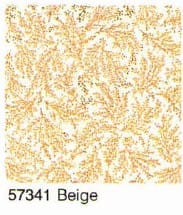
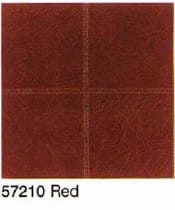
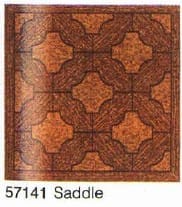
Asphalt asbestos and vinyl-asbestos floor tiles were produced in 9" x 9", 12" x 12", and even 18" x 18" as well as in decorative strips, and in thicknesses of 1/16", 3/32", and 1/8", also in 0.08 gauge. Some sheet flooring or resilient flooring also contained asbestos, as did floor tile mastics.
This photo guide to asphalt asbestos & vinyl asbestos floor tiles for each year shows at least one color photo of each floor tile style or pattern in an example color. A list below each group of photos includes the names of and links to additional photos for other colors of these styles.
Asbestos is safe and legal to remain in homes or public buildings as long as the asbestos materials are in good condition and the asbestos can not be released into the air.
To identify a particular asphalt-asbestos or vinyl-asbestos floor tile pattern & color, start in the image group most likely to be the same age as your building.
If you don't find your floor tile or sheet flooring by looking forward from that that year, you should also look backwards in the earlier years as your specific flooring pattern & color may have first appeared in an earlier year. For other tile brands than Armstrong, see the brand name floor tile links included in this list.
If you can identify your floor tile collection name or model number, or if you recognize it in the extensive library of flooring color and pattern photographs provided in these pages, laboratory testing of the sample to screen the flooring for asbestos may be unnecessary.
Our home page for asbestos-containing floor tiles is
at ASBESTOS FLOOR TILE PHOTO ID GUIDE
Many of the colors and patterns of asphalt-asbestos or vinyl-asbestos floor tiles were manufactured over many years and may appear in more than one of the floor tile photo collections listed by date range here.
For each year we list the names of the tile patterns sold during that year, we include representative color images of the floor tiles, and throughout the entire floor tile pattern & color history series we include each floor tile color & pattern of the floor tile in the first year that it appeared , and we include representative colors and patterns in other years.
Examples of floor tile packaging, labeling, and other information can be found throughout the flooring photo collections listed here.
If you do not know the brand name of your flooring you can take a quick look at example photos of the product line of each manufacturer given
at ASBESTOS FLOORING IDENTIFICATION GUIDE INDEX - all brands, all years .
...
Reader Comments, Questions & Answers About The Article Above
Below you will find questions and answers previously posted on this page at its page bottom reader comment box.
Reader Q&A - also see RECOMMENDED ARTICLES & FAQs
Is this damaged flooring late 1980's? Is it an asbestos hazard?
Wondering if this is likely original 1980s install flooring or later based on the design. I have already worked to tear it up and paused when a friend raised the potential for asbestos. You can see the pattern in upper left, and the bottom of the linoleum or vinyl has a light gray paper-like backing.
What gives me hope are features on the back of the flooring where you can see floor concrete along with higher topography bright stuff which I believe is related to patching done on the concrete elsewhere in the house that is the same color and is in the shape of fracture paths (a mold of those fractures) that adhered to the floor and came off with it when i tore it up that makes sense. - On 2023-02-18 by Eric
Reply by InspectApedia Editor - flooring installed over concrete fractures repair
@Eric,
Thanks for the photo, glad it worked.
Are you saying that the concrete repair of fractures was done at a later date than the original 1980s flooring installation?
If so, AND if the flooring in question was installed after those concrete repairs, AND if that repair was done after 1986, it is unlikely to contain asbestos as that was the last year that asbestos containing flooring was allowed.
If installed 1986 or earlier, keep in mind that the flooring, but also its backing or adhesive may contain asbestos. I can't tell from a photo alone since similar patterns sometime contained asbestos and other times not.
In the Recommended Articles list just above on this page, see the live link for
DOES THIS FLOOR CONTAIN ASBESTOS? - 5 easy questions to tell if your FLOOR probably contains asbestos
Because some white-backed sheet flooring contains asbestos, you may decide to have the flooring tested by an asbestos test lab, and if you avoid creating any further dusty mess (grinding, chopping, sawing, sanding) the floor, you will minimize the risk of sending potentially harmful dust about your home.
For the demolition you've already done, damp wiping and use of a HEPA vacuum will help clean up the current exposure. Our discussions on hazard reduction and floor removal are also above in that same article list.
Keep in mind that the simplest and safest way to deal with asbestos containing flooring is to leave it in place and cover with new flooring.Followup by Eric
@InspectApedia Editor Thanks for the detailed response!
Unfortunately I just bought this unit and do not have a timetable for when the white patchwork was done, but I assume some time had to pass before concrete cracking became noticeable, or perhaps more likely the cracking was only first noticed and addressed when a previous owner first decided to change the flooring in the kitchen (hopefully past 1986).
I'm guessing that is less likely to have happened before 1986 (unless someone changed it based on the way it looked despite being pretty new). Do you happen to know how fast concrete slabs poured into steel pans can crack?
Does it seem realistic that sag could have happened within 5-6 years of the place being constructed to the point where the owner would need to replace the floor and replace it with another abestos containing floor prior to 1986?
I would also like to ad I have scheduled a test of the floor and air per your suggestion. I will have someone come in with a wet hepa vac as you have suggested if it comes back positive. Luckily the kitchen and condo itself is small so hopefully abatement will be relatively easy if needed.
Thanks again for your help and appreciate if you or anyone else have anything more to add.
Lesson learned on my part.
Thanks!
EricReply by InspectApedia Editor - building history may help identify type of flooring
@Eric,
Of course, we know nothing about your building's history, its construction methods, or the site conditions when built.
Foundation settlement, or 'sag' as you call it, could happen within a short time frame, even within weeks of pouring the concrete. Of course, it may also take a lot longer than that for cracks to show up. My point is that time itself won't necessarily give you an idea of when the fractures occurred.
Do you know how many owners there were before you and their dates of purchase? One possibility would be that a new owner made a flooring change at time of purchase. Not definitive but perhaps another clue.
Even if you're not using a HEPA vac right away, you can sure do some damp wiping to mitigate some of the dust that may be present.
We would sure like to hear the results of any testing you have done as that will help other readers as well.
If you need help finding a testing site, please see
ASBESTOS TESTING LABS
https://inspectapedia.com/hazmat/Asbestos_Test_Lab_Lists.php
Keep us posted.
Looking for more of this sheet flooring with square dark and light colors
I would love someone's assistance finding this (sheet) vinyl. We're told it's discontinued, but still holding out hope to find 200 square feet somewhere. Any help is appreciated! - On 2023-01-25 by Mindy in Ohio -
On 2023-01-25 by InspectApedia Editor
@Mindy in Ohio,
Can you confirm a brand or pattern number?Take a look at the back of the flooring.
I'm worried that this early 1990's sheet flooring contains asbestos
Hello! Pulled up this linoleum. Didn't realize could be asbestos.
I believe it is early 90s but can't find info anywhere. Have attached photo of floor. There is alot of paper/glue stuck to OG hardwood floors now and im nervous about scraping it off. Please help! - On 2022-08-05 by Colleen
Reply by InspectApedia-911 (mod) - 1990s flooring in the US doesn't contain asbestos
@Colleen,
1990s sheet flooring or other flooring products made and sold in the US would not be expected to contain asbestos.
See details at
https://inspectapedia.com/hazmat/DIY-Asbestos-Floor-Test.php
DOES THIS FLOOR CONTAIN ASBESTOS? - 5 easy questions to tell if your FLOOR probably contains asbestos -
Is this "linoleum" from the 1990's?
Hi there, I’m in the process of removing wax build up on my linoleum and I was hoping someone could identify if it’s from the 1990s before I continue. Thank you! -On 2022-02-11 by Christopher -
Reply by Inspectapedia Com Moderator
@Christopher,
Sorry, no I can't give the age of that flooring beyond saying it's probably 1980's or later.Sheet flooring patterns like that are popular enough that they may have been made over more than one decade.
Identify this late 1980's floor - Asbestos?
Can anyone identify this floor? Has to be late 80s as it is under my cabinets that are stamped March 1989.
Wonder if there is asbestos in it before attempting to remove it - On 2021-01-26
by Chris
-
Reply by (mod) - in the U.S. asbestos is not likely to be found in floors made after 1986
Vinyl flooring made in the U.S. after 1986 would not be expected to contain asbestos, Chris.
What kind of flooring is this - vinyl sheet?
Can someone help me identify what this is? My house was built in 1992 and I think this is a vinyl sheet, but not sure.
In some parts, if I clean it with Oil Soap, a thin sheet or peel of dirt comes off, but I'm not sure if that is the vinyl tile design.
At first I thought individual tiles were sealed with grout or something, because in some parts the grout type line looks really dirty at the edges.
Also, If I accidentally burn 1 tile a bit, does that mean I replace the whole sheet or my whole kitchen flooring? - On 2020-07-25
by Serene
-
Reply by (mod) - replace damaged vinyl sheet flooring without replacing the whole floor: Cut an Patch
Serene
That sounds pretty fragile to me too. Indeed some low-cost vinyl floorings have only a very thin and somewhat fragile top layer of sealant and pattern. If you wear through that there's no repair but to replace the floor.If the floor is not glued down you might be able to lift it up to see the manufacturer's markings and then to know if you can match it.
It is often possible to use a straight-edge to cut out damaged vinyl sheet flooring and then to glue in a replacement if you can buy a suitable matching replacement.The new floor may be slightly different in color.
Key is to work using a metal straightedge and to make perfectly straight cuts into the old and new flooring. I make those cuts along a line that is already pre-existing in the flooring pattern, such as those "grout lines" in your floor. That makes the cuts less obvious once the repair is complete.
1959 home that has some sort of 12x12 vinyl installed directly on particle board.
Thank you for the informative site! I have a 1959 home that has some sort of 12x12 vinyl installed directly on particle board.
I have looked though all the pages here on the topic, but haven't found a match. It is a parquet design (how do I post pics?), and the pattern is a thin layer of vinyl stuck on top of an 1/8th inch nude colored material (not paper-backed), and the design can be peeled off easily.
Between the backing and the particle board, there is no visible adhesive at all. No residue is left behind from the sample I pulled.
Based on this page, it seems this is a bit newer, given the thin peel of design, but I am not sure.
I can't find much about these types of tiles. Any insight would be much appreciated! Estimated year production? Thanks! - On 2016-08-29
by Chris
- 1
Reply by (mod) -
Chris,
Particleboard subflooring would be unusual in a 1959 home - so the floor may be newer than you think.
You can use the page top or bottom CONTACT link to send us photos for comment, but if you've not found a matching photo for your flooring after looking through our photo guides, and if you are pretty sure the flooring was installed before the mid 1980's, it would be smart to presume the floor tiles contain asbestos and to avoid making a dusty mess.
If you need to remove the flooring and can lift tiles away intact dust ought not be much of a worry.
On a home built in 1959 the flooring could have been installed in virtually any year since then, though 12x12 tiles are often of the more recent decades.
You can also look in the ARTICLE INDEX to ASBESTOS HAZARDS (live link up in the More Reading section of this page) to see articles on ASBESTOS FLOOR HAZARD REDUCTION that will help.Followup by Chris
Thank you for the response! Do you have any information you can share regarding vinyl that has peel-able design on the surface, and no added adhesive? Is that a newer version of vinyl?
I have not been able to find anything online regarding flooring with a thin layer of vinyl that peels off the backing easily. Is this common with older vinyl? -On 2016-08-29
Question: Armstrong diecut inserts from around 1952 - ways to seal these floors?
Am looking for information on Armstrong diecut inserts from around 1952. Also are there any recommended ways to seal these floors so you can enjoy the look but without any asbestos concerns? Thanks, Sarah - Sarah 6/23/11
Reply: gentle cleaning followed by floor restorer clear coating protects from asbestos fiber release
Sarah:
Our photos show examples of some of the diecut flooring inserts from the 1950's; I'm not sure what other information you seek.
About sealing vinyl-asbestos tile floors, especially in residential use where school or public regulations and public access worries don't apply, I've had great success using clear-coating floor restorer products.As you can see at ASBESTOS FLOORING LEFT IN PLACE, we just did this recently in a New York home. The floor was washed with mild detergent and water. Then we used a spray cleaner recommended by the floor restorer manufacturer.
The spray cleaner removes old wax residues. Next we used a magic marker to color in some gouges that had marred the floor surface. Finally we coated the flooring with the floor restorer product. The floor looked new, and great.
In sum, if you maintain a hard clear coating on top of the floor surface you won't be releasing any measurable level of asbestos fibers by normal foot traffic.Also see ASBESTOS FLOORING HAZARD REDUCTION for more ways to reduce the asbestos hazard in asbestos-suspect or presumed asbestos-containing flooring.
Question: what do we do with asbestos tiles under carpeting?
Found what I believe to be asbestos tiles under carpet in all 4 bedrooms of a house my daughter purchased.
The house is 100 + age so this indicates these tiles would be asbestos. Some are damaged through age and also have been stapled to hold the underpad of carpeting and also the carpet tack around the edges.
What is the hazard of the staples and tack? Should we be concerned about fiber leakage thru these holes and various damage in the rooms. Thank you - Leaha 9/7/11
Reply: Leave asbestos-suspect floor tiles or sheet flooring under carpeting alone
Leaha
While one cannot assert the age of a flooring material necessarily from the age of a house (as flooring can be installed long after original construction) it's reasonable to use caution about old-looking flooring in a 100 year old home before knowing much more.
But it's unlikely that there would be measurable asbestos particle movement up through wall to wall carpeting over floor tiles; the hazards would more likely arise during demolition.
See ASBESTOS FLOORING HAZARD REDUCTION (article link at the ARTICLE INDEX the bottom of this article ) for advice about minimizing the hazards should you need to remove material.
If nevertheless you are worried about the health and safety of building occupants, you'd want a professional inspection for all conditions there; a loose railing or step or a fire hazard could be a greater risk that should not go ignored.Finally, you could order asbestos tests on settled house dust or even air sampling if you are very anxious about the matter; frankly those steps would not be my first concern.
Question: identifying various other brands and product numbers of floor tiles
do you know if the SEARS brand HOMART 64-7169 asphalt floor tile contained asbestos? - Paul Wright 9/22/11
Have you heard of Dura Floor Plastic Asphalt Tiles? Do they contain asbestos? - Jo Lynn Judka 10/24/11
I have 12" x 12" tile in the basement just like the pattern San Roque Gold 57161 from 1980.
However, this tile is not 1/8 thick but 1/16 and it was peel & stick. Would this contain asbestos? - David 11/27/11
Is there a way I can forward someone a photo of a school floor to determine if it contains asbestos? I am unable to get back into the building It is closed, but the school dept wants to open it again and is saying that there isn't a problem.
I looked through the tiles on your site, but oculdn't find an exact match. The school was built in 1950-1960, but we have no evidence that the tiles have been replaced. Can you help? -
we have an armstrong floor tile (black color) with the following numbers on the back L4 1230 021898. We don't know the year it was installed. Does it contain asbestos? Is there a way to cross reference these numbers? - Dan 5/1/12
We have the San Roque pattern sheet vinyl. Did Armstrong use the same patterns at a later date for their sheet vinyl but without asbestos? We have already started to remove it and I am concerned. - Sue 10/24/2012
We have vinyl sheet flooring that was put in about mid 1984. Is this anything to worry about? When exactly was asbestos banned in the manufacture of sheet flooring? - Peter 11/6/2012
Reply:
David, naturally by email alone no one can say with certainty whether or not a floor tile contains asbestos, but if your flooring matches one of the ACM floor tiles we illustrate here, AND if you are confident about the age (as you suggest) most likely it is an asbestos-containing product. And yes, for sure there were some peel-and-stick floor tiles that contained asbestos in the tile baking.
That does not necessarily mean that you need a costly asbestos remediation job - it depends on the condition of the surface, use made of the area, etc. If the floor is sound you may have the option of simply covering it with a new material.JoLynn, sorry we don't have information about DuraFloor plastic asphalt tiles. Do you know the age of the product? You're welcome to send us photos (see the CONTACT link at top, side, bottom of our pages), and I'll research further. Certainly up to the early 1980's many asphalt floor tile products contained asbestos.
Dan, while we have published product and lot numbers for some floor tile products, there are just too many of them, thousands.
Unlike mechanical equipment like water heaters or furnaces, I have not found a standard of correlation between product numbers and date of manufacture, though it probably was included in widely varying ways by individual manufacturers.
You can narrow down the asbestos question by these bits of additional information
- noting the age of the building itself as that sets the earliest plausible date for its floor materials +/- a year or so to allow for flooring sold from stock
- noting the date of any renovations of the building
- noting whether or not there are multiple layers of flooring or other similar changes that give a renovation history
- noting information on any packaging used for the floor tiles - sometimes an extra box of floor tiles is left and stored in a building, intended to supply future repairs or changes to the floor
- comparing the appearance of your flooring to the photographs we provide in these tile identification articles
- sending a small sample of flooring to a certified asbestos testing labWatch out: For a tile floor of unknown constituents, do not do something foolish such as grinding, sanding, power sawing, or a dusty messy demolition.
Peter,
I think you mngh want to ask Armstrong, but in NY case, if you remove materials following the recommended procedures and avoid making a dusty ness you should be OK
Question: worried about removing old floor tiles: what are my options?
Hi there, being naive and not aware that floor tiles may contain asbestos - I began removing some older tiles from under the carpet in my kids room.
After seeing a warning on a Home Depot website - we stopped the removal.
Is there any way of testing or visually confirming the possibility of it containing asbestos? I was working in the area for approximately 2 hours without any
breathing apartus, etc. What are my options at this point? My wife is freaking out. Thanks - Sean M 1/22/12
Reply:
Worries about what to do now about possibly hazardous dust you might have breathed is a question to ask your doctor.
If you have not already done so, it might be worthwhile performing some simple air or settled dust tests (preferred) in your home to determine if further expert cleaning is needed.
Question: Test Results for Armstrong Sheet Flooring - 70% Asbestos
 In one of the asbestos pages of your site ( this page - Ed.), your second photo is of a sheet layment. The text about the photo clarifies that the person who sent the photo was confused about Armstrong and Congoleum.
In one of the asbestos pages of your site ( this page - Ed.), your second photo is of a sheet layment. The text about the photo clarifies that the person who sent the photo was confused about Armstrong and Congoleum.
I wanted to let you know that I have that exact same sheet layment and had it tested. It's 70% asbestos.
Thought you may want to let readers know so they can save the cost of testing and just deal with the issue accordingly.
I appreciate your site. Thank you for taking the time to put together all the information. - D.H. 10/11/2012
Reply:
Thank you so much D.H. for the floor covering test result confirming asbestos content in this material. We a welcome critique, questions, or content suggestions for our web articles, and as your feedback illustrates, working together and exchanging information makes us better informed than any individual can be working alone.
Thank you to our readers for their generous comments:
I appreciate your site. Thank you for taking the time to put together all the information. - D.H. 10/11/2012
Thank you for the informative site! - On 2016-08-29
by Chris
...
Continue reading at CONGOLEUM-NAIRN FLOOR TILES & LINOLEUM or select a topic from the closely-related articles below, or see the complete ARTICLE INDEX.
Or see these
Recommended Articles
- ASBESTOS TEST RESULTS for TILE & SHEET FLOORING - confirmation by lab tests or documents
- ASBESTOS FLOOR TILE PHOTO ID GUIDE - home
- ASBESTOS FLOOR TILE IDENTIFICATION COLOR KEY - home
- ASBESTOS FLOORING HAZARD REDUCTION
- ASBESTOS FLOORING IDENTIFICATION
- ASBESTOS FLOORING IDENTIFICATION GUIDE INDEX - all brands, all years
- ASBESTOS FLOORING REMOVAL GUIDE
- ASBESTOS REMOVAL, WETTING GUIDELINES
- ASBESTOS RISK ASSESSMENT
- ARMSTRONG SOLARIAN NO-WAX FLOORING HISTORY
- ASBESTOS TEST RESULTS for TILE & SHEET FLOORING
- ASBESTOS TESTING LAB LIST
- ASPHALT & VINYL FLOOR TILE HISTORY
- DOES THIS FLOOR CONTAIN ASBESTOS? - 5 easy questions to tell if your FLOOR probably contains asbestos -
- FLOOR COVERINGS: 1900 - 1949
- MARBLE / STONE CHIP PATTERN FLOORING ASBESTOS
- RESILIENT SHEET FLOORING ID GUIDE
Suggested citation for this web page
1989 & LATER ARMSTRONG ACCOFLEX FLOORING & TILES at InspectApedia.com - online encyclopedia of building & environmental inspection, testing, diagnosis, repair, & problem prevention advice.
Or see this
INDEX to RELATED ARTICLES: ARTICLE INDEX to ASBESTOS HAZARDS
Or use the SEARCH BOX found below to Ask a Question or Search InspectApedia
Ask a Question or Search InspectApedia
Try the search box just below, or if you prefer, post a question or comment in the Comments box below and we will respond promptly.
Search the InspectApedia website
Note: appearance of your Comment below may be delayed: if your comment contains an image, photograph, web link, or text that looks to the software as if it might be a web link, your posting will appear after it has been approved by a moderator. Apologies for the delay.
Only one image can be added per comment but you can post as many comments, and therefore images, as you like.
You will not receive a notification when a response to your question has been posted.
Please bookmark this page to make it easy for you to check back for our response.
IF above you see "Comment Form is loading comments..." then COMMENT BOX - countable.ca / bawkbox.com IS NOT WORKING.
In any case you are welcome to send an email directly to us at InspectApedia.com at editor@inspectApedia.com
We'll reply to you directly. Please help us help you by noting, in your email, the URL of the InspectApedia page where you wanted to comment.
Citations & References
In addition to any citations in the article above, a full list is available on request.
- Our recommended books about building & mechanical systems design, inspection, problem diagnosis, and repair, and about indoor environment and IAQ testing, diagnosis, and cleanup are at the InspectAPedia Bookstore. Also see our Book Reviews - InspectAPedia.
- In addition to citations & references found in this article, see the research citations given at the end of the related articles found at our suggested
CONTINUE READING or RECOMMENDED ARTICLES.
- Carson, Dunlop & Associates Ltd., 120 Carlton Street Suite 407, Toronto ON M5A 4K2. Tel: (416) 964-9415 1-800-268-7070 Email: info@carsondunlop.com. Alan Carson is a past president of ASHI, the American Society of Home Inspectors.
Thanks to Alan Carson and Bob Dunlop, for permission for InspectAPedia to use text excerpts from The HOME REFERENCE BOOK - the Encyclopedia of Homes and to use illustrations from The ILLUSTRATED HOME .
Carson Dunlop Associates provides extensive home inspection education and report writing material. In gratitude we provide links to tsome Carson Dunlop Associates products and services.


